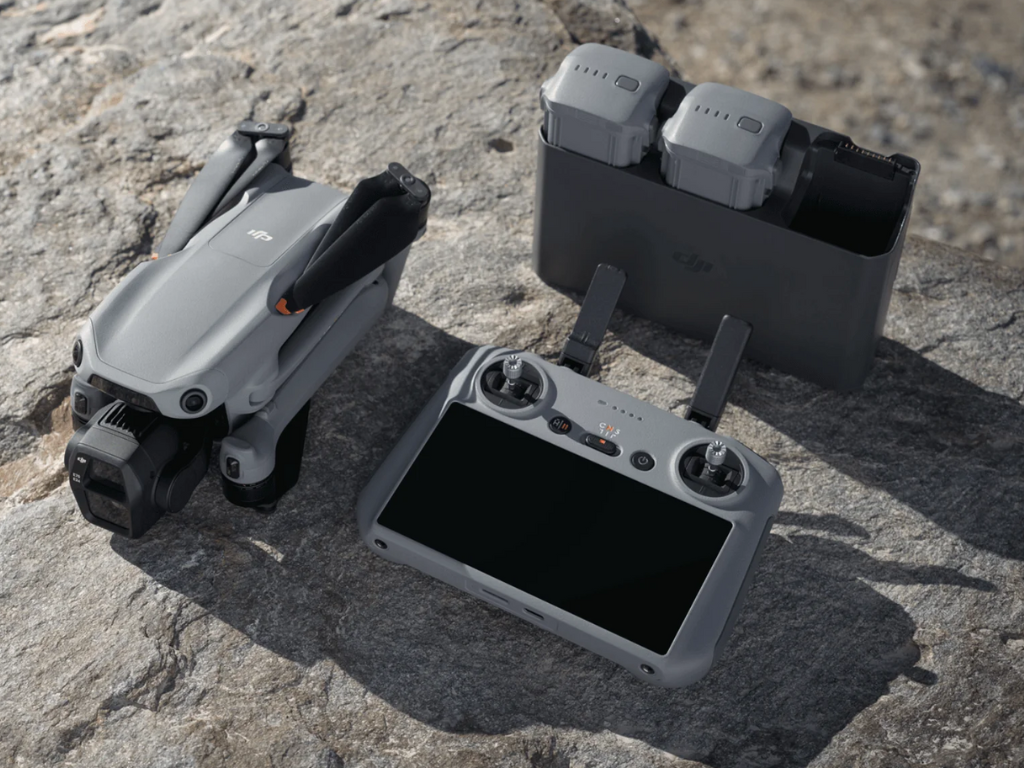
Products
Published on 17 Oct 2024
James Willoughby
DJI Air 3S vs DJI Air 3 vs Air 2S
How does the DJI Air 3S compare to the DJI Air 3 and DJI Air 2S?
In-depth comparison between the DJI Air 3S, DJI Air 3, and DJI Air 2S;
Upgrades on the DJI Air 3S include an enhanced imaging system, new intelligent modes such as Free Panorama, and bolstered safety features, including forward-facing LiDAR.
DJI has unveiled the latest drone in its Air Series, with the release of the DJI Air 3S. This new platform comes 15 months after the Air 3, and more than three years since the Air 2S was brought to market.

So, how does the DJI Air 3S compare to its predecessors, and is it worth an upgrade? Read our comparison blog to find out.
Key Specs At A Glance
Before we compare the three drones in more depth, here is an overview of the key specifications.
DJI Air 3S | DJI Air 3 | DJI Air 2S | |
|---|---|---|---|
Weight | 724 g | 720 g | 595 g |
Number of cameras | 2 | 2 | 1 |
Image Sensor | Wide-angle Camera: 1" CMOS, 50MP effective pixels. Medium Tele Camera: 1/1.3" CMOS, 48MP effective pixels. | Wide-angle Camera: 1/1.3" CMOS, 48MP effective pixels. Medium Tele Camera: 1/1.3" CMOS, 48MP effective pixels. | 1" CMOS, 20MP effective pixels. |
Max Video Resolution | 4K/60fps HDR or 4K/120fps | 4K/60fps or 4K/100fps | 5.4K/30fps |
Flight Time | 45 minutes | 46 minutes | 31 minutes |
Obstacle Sensing | Nightscape Omnidirectional: Forward, Backward, Upward, Downward, Left, Right. Equipped with forward-facing LiDAR. | Omnidirectional: Forward, Backward, Upward, Downward, Left, Right. | Forward, Backward, Downward, Upward |
Max Video Transmission Range (CE) | O4: 10km | O4: 10km | O3: 8km |
On-board Storage | 42GB | 8GB | 8GB |
Appearance & Design
At first glance, there isn't a huge difference between this drone trio. Being from the same family, the Air 3S, Air 3, and Air 2S are foldable and compact quadcopters - ideal for content creation on the go and particularly suited to travel photography. While the Air 2S is the smallest and lightest of the three, the Air 3S and Air 3 are still portable platforms. One of the most significant differences is that the Air 2S has one sensor, while the Air 3S and Air 3 have two: a wide-angle camera and a medium-tele camera. We'll look at this further shortly.
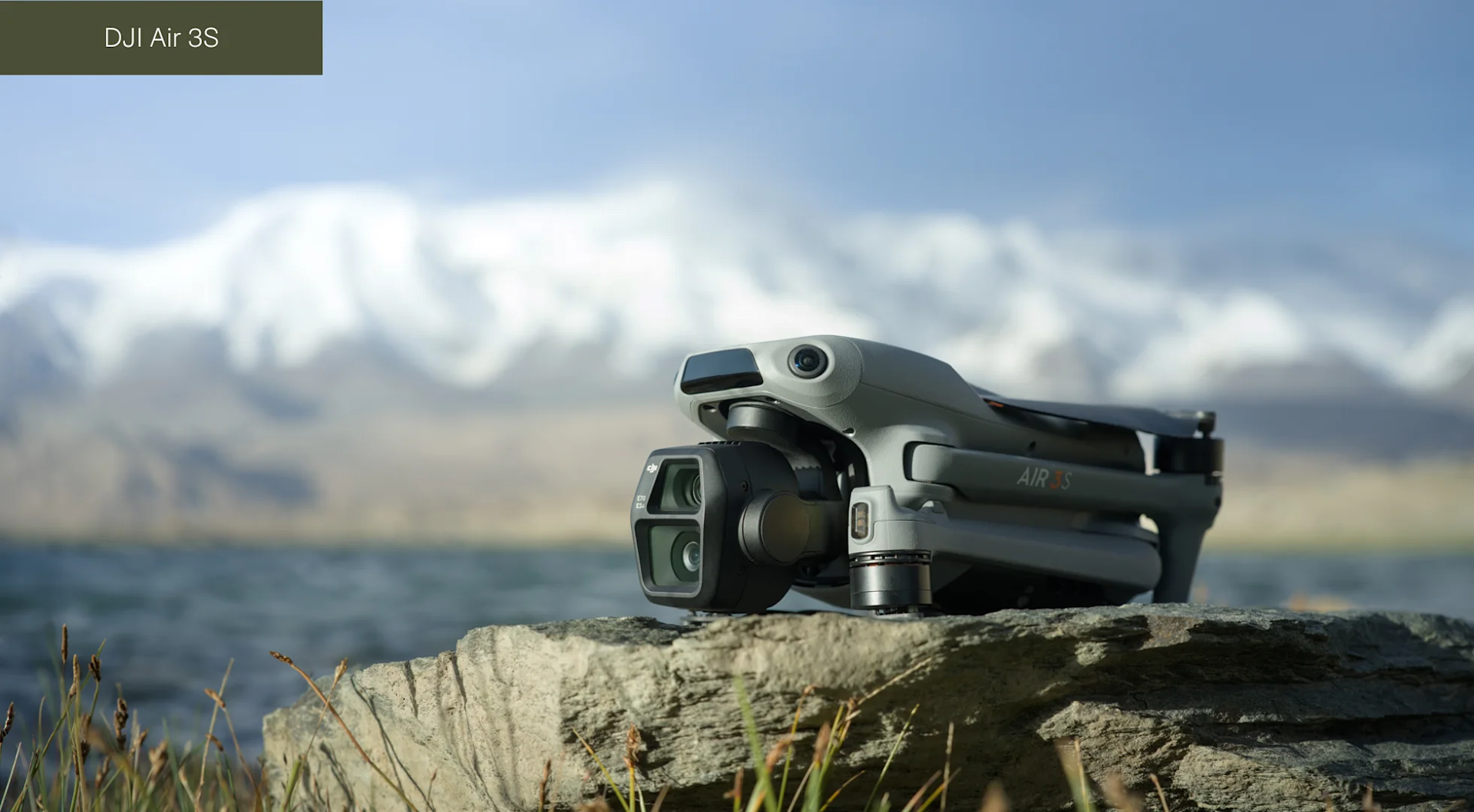
Meanwhile, a look at the front of the DJI Air 3S reveals the drone's forward-facing LiDAR module: A stellar addition which helps the aircraft achieve nightscape omnidirectional obstacle sensing. Again, we'll cover this later. The table below provides an overview of the dimensions of the Air 3S, Air 3, and Air 2S.
DJI Air 3S | DJI Air 3 | DJI Air 2S | |
|---|---|---|---|
Weight | 724 g | 720 g | 595 g |
Dimensions (Length x Width x Height) | Folded: 214.19 x 100.63 x 89.17 mm Unfolded: 266.11 x 325.47 x 106.00 mm | Folded: 207 x 100.5 x91.1 mm Unfolded: 258.8 x 326 x 105.8 mm | Folded: 180 x 97 x 77 mm Unfolded: 183 x 253 x 77 mm |
Camera
The DJI Air 3 was the first Air drone to feature a dual-primary camera system, with its 1/1.3-inch CMOS wide-angle camera and 1/1.3-inch CMOS 3x medium tele camera. The Air 3's cameras capture 48MP stills and shoot 4K/60fps HDR (and 4K/100fps), and both sensors have different focal lengths, providing greater creative freedom.
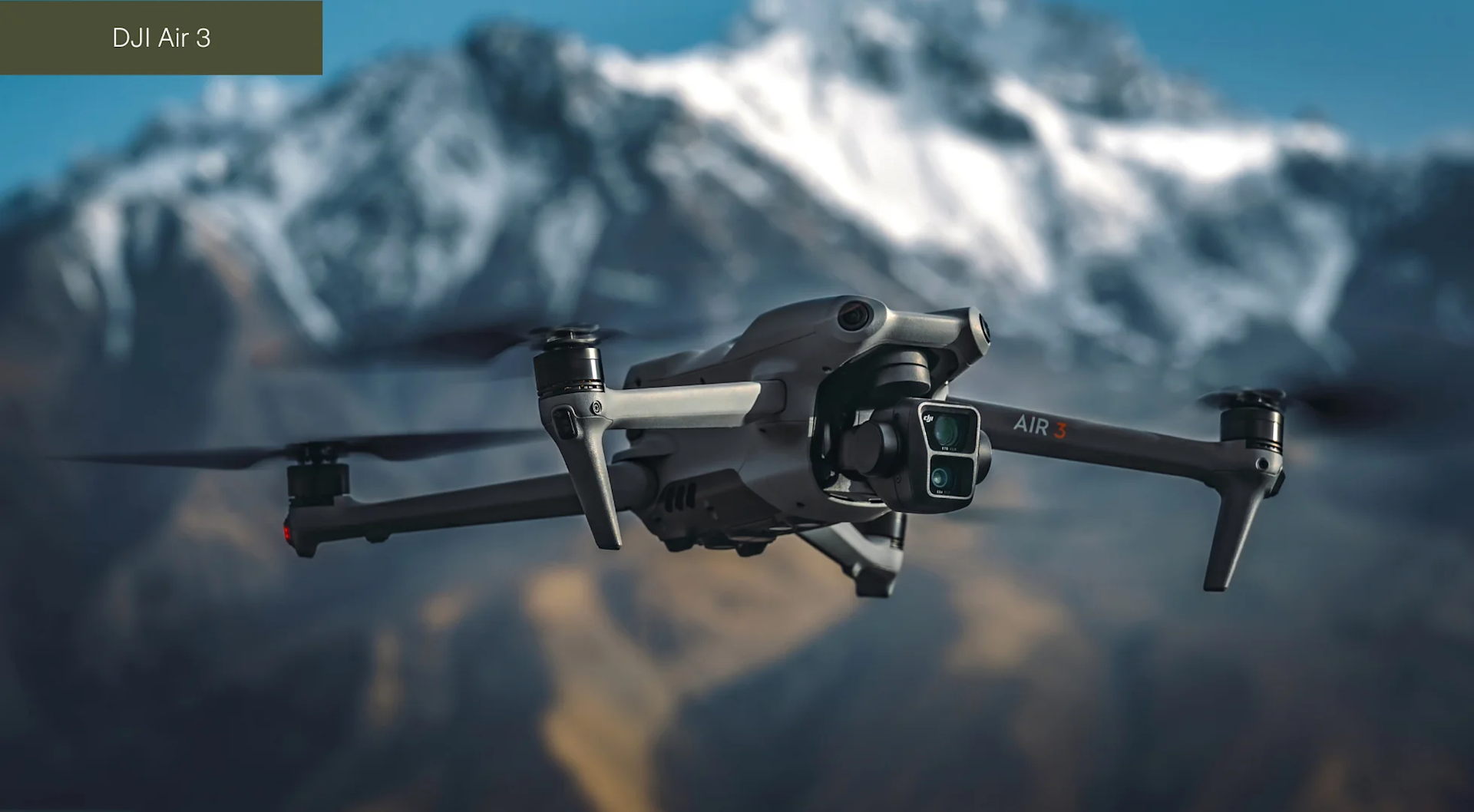
This was a decent upgrade from the DJI Air 2S' single camera, but there were grumblings from some who felt that the step-down in size from the 2S's solitary 1-inch sensor wasn't the best trade off.
No such problems with the Air 3S, though. Thanks to an enhanced imaging system, the Air 3S keeps the Air 3's two-camera array, but its wide-angle sensor has been increased to the 1"-inch CMOS to match the Air 2S.
It's the best of both worlds and offers enhanced creative licence: The larger 24mm primary camera (compared to Air 3) is ideal for capturing expansive landscapes with improved clarity and field of view. In comparison, the 70mm medium telecamera excels at portrait and vehicle shots.
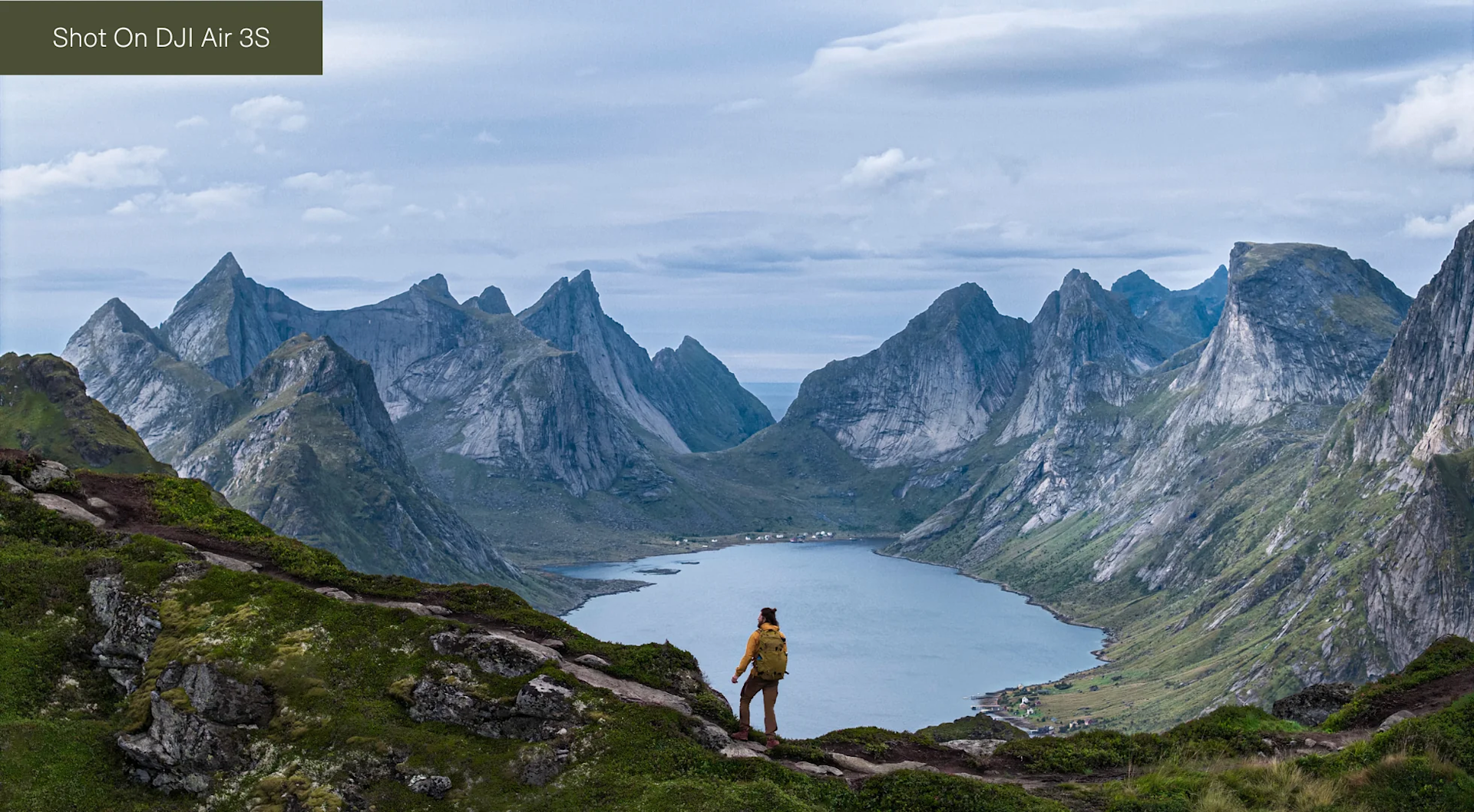
Things don't stop there, either. The Air 3S' wide-angle sensor shoots 50MP stills (and the 1/1.3-inch medium tele camera shoots 48MP stills), and both sensors are capable of 4K/60fps HDR and an increased 4K/120fps for slow-motion. The Air 3S also boasts 14-stops HDR, compared to the Air 3's 12-stop, and the Air 2S' 12.6 stops. As mentioned, the Air 2S has the one sensor, but in fairness, it is a corker! Its 1-inch sensor can capture 20MP images and tops out at 5.4K at 30fps. It is also capable of 4K/60fps, and 1080/120fps.
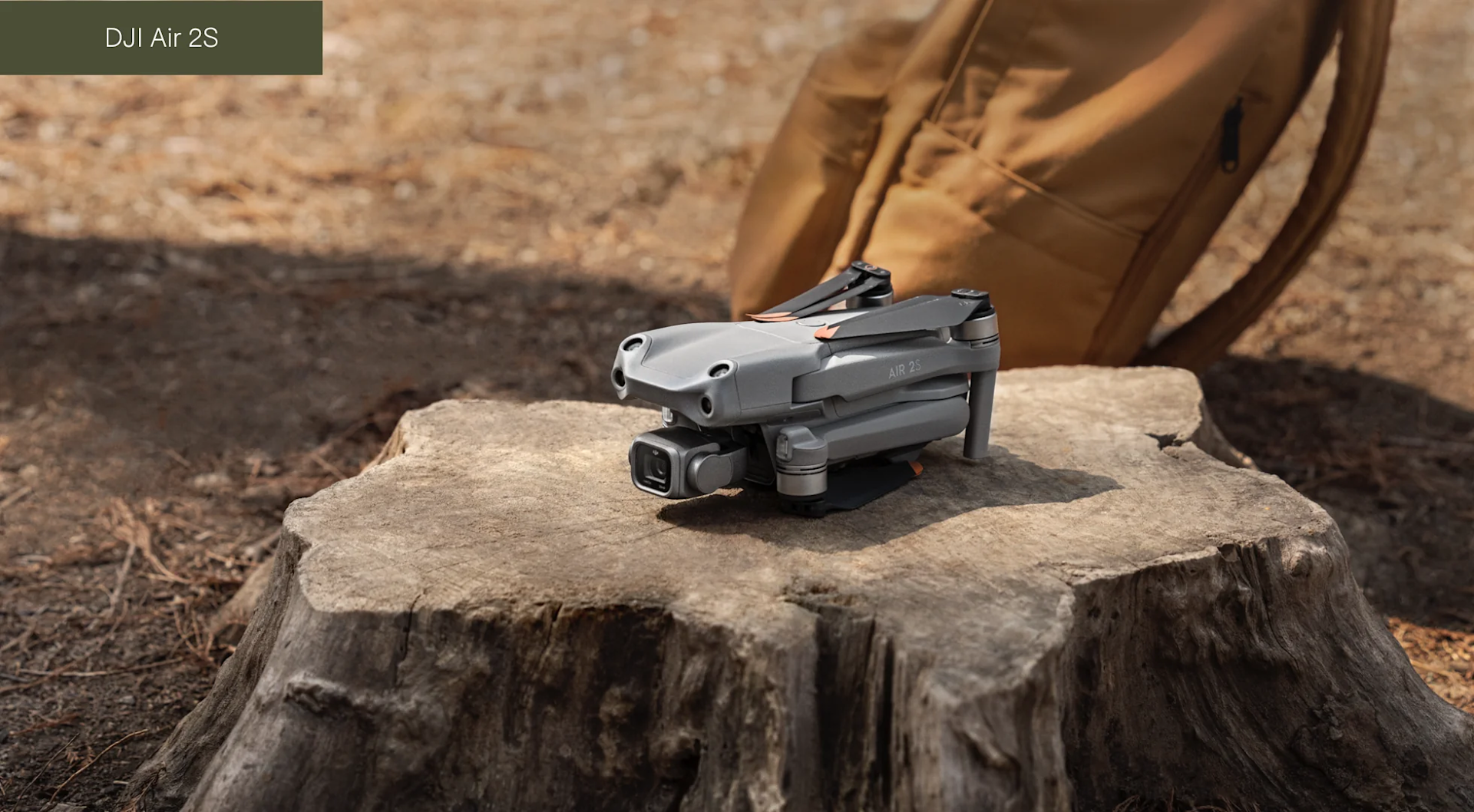
But while the DJI Air 2S is capable of capturing stunning details, the dual-camera set-up of the Air 3S and Air 3 offer more dynamic shots. Once you've captured your content, you need somewhere to store it. And the DJI Air 3S duly delivers, offering a tasty 42GB of on-board storage, compared to the 8GB of built-in storage on the Air 3 and Air 2S. This can be increased on all three drones by using a separate microSD card. The camera specifications are outlined in more detail below.
DJI Air 3S | DJI Air 3 | DJI Air 2S | |
|---|---|---|---|
Image Sensor | Wide-angle Camera: 1" CMOS Medium Tele Camera: 1/1.3" CMOS | Wide-angle Camera: 1/1.3" CMOS Medium Tele Camera: 1/1.3" CMOS | 1" CMOS, 20MP |
Lens | Wide-angle Camera: FOV: 84° Format equivalent: 24mm Aperture: f/1.8 Medium Tele Camera: FOV: 35°Format Equivalent: 70mm | Wide-angle Camera: FOV: 82° Format equivalent: 24mm Aperture: f/1.7 Medium Tele Camera: FOV: 35°Format Equivalent: 70mm | FOV: 88° 35 mm Format Equivalent: 22 mm Aperture: f/2.8 |
ISO Range | 100-12,800 (Normal) 100-3,200 (D-Log M) 100-3,200 (HLG) | 100-6,400 (Normal) 100-1,600 (D-Log M) 100-1,600 (HLG) | 100-3200 (Auto) 100-6400 (Manual) 10-Bit Dlog-M Video:100-800 (Auto)100-1600 (Manual) |
Max Video Resolution | 4K/120fps 1080p/240fps Vertical Shooting: 2.7K/60fps | 4K/100fps 1080p/200fps Vertical Shooting: 2.7K/60fps | 5.4K/30fps 4K/60fps 1080p/120fps2.7K/60fps |
Colour Mode | Normal HLG D-Log M | Normal HLG D-Log M | Normal HLG D-Log |
Digital Zoom | Wide-angle Camera: 1-2.9x Medium Tele Camera: 3-9x | Wide-angle Camera: 1-3x Medium Tele Camera: 3-9x | 8x |
Effective Pixels | Wide-angle Camera: 12MP/50MP Medium Tele Camera: 12MP/48MP | Wide-angle Camera: 12MP/48MP Medium Tele Camera: 12MP/48MP | 20 MP |
Pixel Size | Wide-angle Camera: 3.2μm Medium Tele Camera: 2.4μm | Wide-angle Camera: 2.4μm Medium Tele Camera: 2.4μm | 2.4μm |
Internal Storage | 42GB | 8GB | 8GB |
Intelligent Features
All three drones have a suite of intelligent features to streamline content creation, sharing functions such as MasterShots - helping users create professional-level videos with minimal effort. The Air 3 was the first Air drone to feature Waypoints, and the DJI Air 3S retains this feature. Waypoints provide the ability to plan flight routes and shoot actions in advance to achieve difficult camera movements, and save flight routes to repeat the same movements at a later date. On top of this, the DJI Air 3S benefits from a sprinkling of upgrades. The first notable one is Free Panorama.

This lets you create seamless panoramic shots by stitching together multiple images with a manually selected subject or area. The wide-angle camera offers a broader FOV, boosting efficiency when capturing panorama photos, while the medium tele camera significantly reduces image distortion. DJI Air 3S also brings enhanced tracking functionality to the table. While Air 3 and Air 2S have tracking technology, DJI Air 3S has ActiveTrack 360°. This keeps any subject optimally in the frame, allowing Air 3S to avoid perspectives with cluttered backgrounds automatically. It keeps the subject in focus, even if the lower half of their body is partially obscured. The new Subject Focussing feature supports this, keeping your subject in sharp focus, even during manual flight or when the subject moves off-centre.
Safety Features
DJI Air 3S ups the ante when it comes to safety features.
It is DJI's first drone to feature forward-facing LiDAR, which enables it to navigate around obstacles for enhanced safety and achieve nightscape omnidirectional obstacle sensing. This helps to increase flight safety, especially during night-time photography.
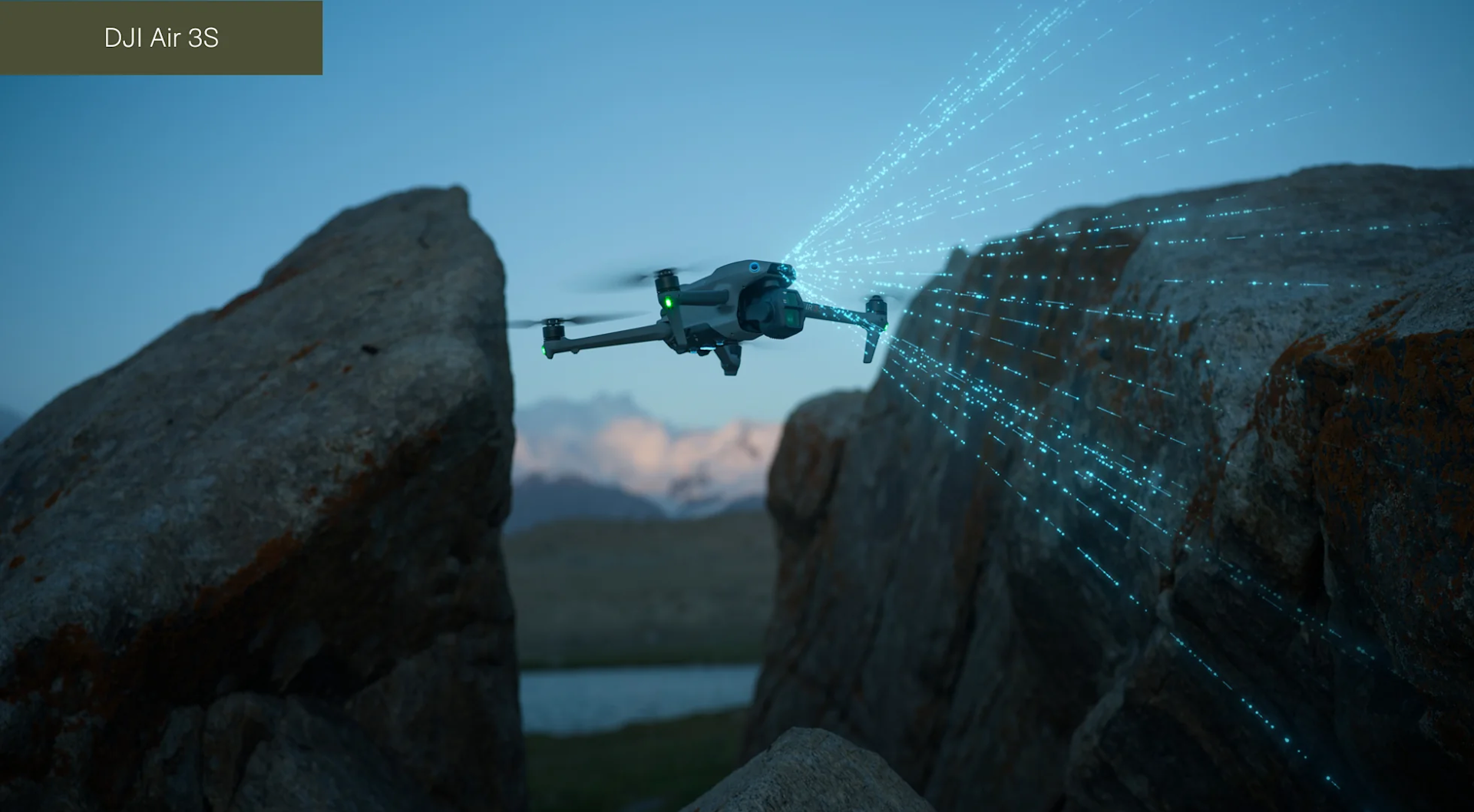
Air 3S is also equipped with Visual Simultaneous Localisation and Mapping (VLSAM) technology, enabling it to conduct real-time onboard mapping. The result: Air 3S supports Return To Home without requiring GNSS signals. In comparison, DJI Air 3 has omnidirectional obstacle sensing, but its ability to detect obstacles in low-light environments is greatly reduced. For instance, its vision system requires a lighting illuminance of > 15 lux, whereas DJI Air 3S requires a lighting illuminance of > 1 lux. DJI Air 2S can easily see obstacles in four directions (forward, backwards, downward, and upward, but not left and right).
Flight & Performance
When it comes to flight and performance, the DJI Air 3S and Air 3 surpass the Air 2S in numerous ways. They have increased flight time, are faster aircraft, can handle stronger wind speeds and can operate in colder temperatures. The DJI Air 3S and Air 3 are also equipped with the upgraded DJI O4, which provides enhanced transmission compared to the DJI Air 2S's O3 transmission.
DJI Air 3S | DJI Air 3 | DJI Air 2S | |
|---|---|---|---|
Max Flight Time | 45 minutes | 46 minutes | 31 minutes |
Max Ascent/Descent Speed | 10 m/s | 10 m/s | 6 m/s |
Max Flight Speed | 21 m/s, or 27 m/s with a tailwind. | 21 m/s | 19 m/s |
Max Wind Speed Resistance | 12 m/s | 12 m/s | 10.7 m/s |
Operating Temperature | -10° to 40°C | -10° to 40°C | 0° to 40°C |
Video Transmission (CE) | DJI O4; 10km; 1080p/60fps | DJI O4; 10km; 1080p/60fps | DJI O3; 8km (CE); 1080p/30fps |
Controllers
At launch, the DJI Air 3S comes with either the DJI RC-N3 or the DJI RC 2 smart controller with a built-in screen.

The Air 3 is compatible with the DJI RC-N2, DJI RC 2, and the DJI RC Motion 3, while the Air 2S can be used with the DJI RC-N1, the DJI RC, the DJI RC Pro, or the original DJI Smart Controller. The table below provides a comparison between the DJI RC, RC Pro, and DJI RC 2 smart controllers. The original Smart Controller has been omitted because it is end of line.
DJI RC 2 | DJI RC Pro | DJI RC | |
|---|---|---|---|
Resolution | 1920 x 1080 | 1920 x 1080 | 1920 x 1080 |
Screen Size | 5.5 inches | 5.5 inches | 5.5 inches |
Frame Rate | 60fps | 60fps | 60fps |
Brightness | 700 nits | 1000 nits | 700 nits |
Storage Capacity | 32GB + expandable storage (with microSD card) | 32GB internal + expandable storage via microSD card | Expandable (with microSD card) |
Operating Time | 3 hours | 3 hours | 4 hours |
Charging Time | 1.5 hours (with 9V/3A charger) | 2 hours (with USB charger at 12 V), 1.5 hours (with USB charger at 15 V) | 1.5 hours (with 5 V/3 A charger) |
Operating Temperature | -10° to 40° C | -10° to 40° C | -10° to 40° C |
Video Output Port | N/A | Mini-HDMI port | N/A |
Antennas | 4 antennas, 2T4R | 4 antennas, 2T4R | 2 antennas, 1T2R |
Weight | Approx. 420 g | Approx. 680 g | Approx. 390 g |
Supported Aircraft | DJI Air 3S DJI Air 3 DJI Mini 4 Pro | DJI Mavic 3 DJI Mavic 3 Classic DJI Mavic 3 Pro DJI Mini 3 Pro DJI Air 2S | DJI Mini 3 Pro DJI Air 2S DJI Mavic 3 Classic DJI Mavic 3 DJI Mavic 3 Cine |
Meanwhile, the table below provides a brief snapshot of the differences between the DJI RC-N3, RC-N2, and RC-N1. These controllers are used in conjunction with a separate smart device.
DJI RC-N3 | DJI RC-N2 | DJI RC-N1 | |
|---|---|---|---|
Weight | 320 g | 375 g | 385 g |
Max Supported Mobile Device Size (L x W x H) | 180 x 86 x 10 mm | 180 x 86 x 10 mm | 180 x 86 x 10 mm |
Max Operating Time | 3.5 hours 1.5 hours when charging a mobile device | 6 hours 3.5 hours when charging a mobile device | 6 hours 4 hours when charging a mobile device |
Charging Time | 2 hours | 2.5 hours | Up to 3 hours |
Operating Temperature | -10° to 40°C | -10° to 40°C | -10° to 40°C |
DJI Air 3S vs DJI Air 3 vs DJI Air 2S: Summary
The innovative Air Series is one of DJI's most beloved drone families, and the Air 2S and then the Air 3 have proudly flown the flag over the last few years. Now, the newest member - the Air 3S - takes things up a notch. Stellar upgrades across the board - from its upgraded 1-inch CMOS primary camera to the forward-facing LiDAR to support nightscape omnidirectional obstacle sensing and the ability to RTH without satellite signals - make it a seriously impressive drone. Indeed, this suite of new features makes it more than worthy of an upgrade.
Purchase the new DJI Air 3S from heliguy™. Benefit from a one-stop-shop infrastructure, including training, in-house repairs, consultancy, next-day delivery, and 50-Day Free Returns on Faulty Items.
